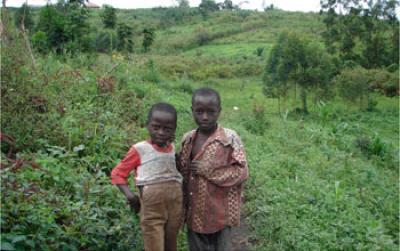If so many poor people live around national parks in developing countries, does that mean that these parks are contributing to their poverty?
Yes, according to the conventional wisdom, but no, according to a 10-year study of people living around Kibale National Park in Uganda that was published this week in Proceedings of the National Academy of Sciences.
To explore the relationship of parks, poverty and biodiversity conservation, Naughton and colleagues monitored 252 families living within three miles of Kibale National Park beginning in 1996. The general trend 10 years later was toward greater prosperity, as measured by access to clean drinking water, ownership of more livestock, and living under an improved roof rather than the traditional thatch.
"Often people have lamented that the poorest of the poor live on the edge of the parks, and the assumption is that it's the parks that are keeping people poor," said Lisa Naughton, a professor of geography at the University of Wisconsin-Madison. The issue matters, she said, because "people say we can't afford to protect biodiversity" if that inflicts further economic hardship on people who are already poor.
"This project demonstrates the value of using integrated approaches to examine the complex interactions between people and the environments they occupy," said Thomas Baerwald, a program director for the Geography and Spatial Sciences Program at the National Science Foundation, which partially funded the study.
"Most of the households came out ahead, are a lot better off than when we started," said Naughton, who has worked in Uganda for more than 20 years. "I go back every couple of years, and people are generally optimistic, some say they never imagined life would be this good."
But 10 percent of the families in the original study sold or lost their land and moved away, which indicates severe poverty, said co-author Jennifer Alix-Garcia, an assistant professor of agricultural and applied economics at UW-Madison. "The sale of land does not sound so terrible to us, but in Uganda, land is your most productive asset, and once you sell it, you don't have anything to rely on."

A 10-year study shows people living around Kibale National Park in Uganda do not experience more poverty than people in other parts of the country. Here two kids are at edge of Kibale National Park.
(Photo Credit: Courtesy Lisa Naughton, University of Wisconsin-Madison)
Although one finds a disproportionate presence of the very poor at the park edge today, more of their very poor counterparts, who lived further away, were forced to sell or give up their land as well, said Alix-Garcia.
"Apparently the park provides a source of insurance; they can hunt, or sell firewood or thatch from the park," she said. "It's misleading. If you look, you see more poor people living near the park. But when you look at the change in assets, you see that the poor people who live next to the park have lost less than poor people who live farther away."
And that suggests that the park is unlikely to explain the increased poverty among its close neighbors.
"Impressions based on one metric at one scale may be misleading, because other factors may be far more significant over broader geographic and temporal scales," said Baerwald. "Research like this that brings together insights from different disciplines provides valuable new insights that can improve policies and management approaches and enhance human well-being."
Parks, landscapes, societies and economies vary widely, and so it's hard to know how well the results will generalize, Naughton admitted. But she said the study was one of the first to look at parks and poverty over the long term, and the results do undermine the conventional wisdom--that national parks are to blame for the poverty found at their borders.
"If you are concerned about the welfare of the people who live around parks, don't assume that it is the park that is trapping them in poverty. Instead of only looking at the park, turn around and look in the other direction. Land is becoming scarce and most public forests have been cleared or privatized. There are many other factors, it's not just the park," Naughton said.
By looking at changes over time, Naughton claimed, it's easier to understand the real course of events. "There is a lot of research looking at poverty in parks, but much of it amounts to looking just at the present-day location of poverty. For 10 years, we have been looking at the changes: What were the starting conditions? What were the ending conditions? And did the park matter?"
Source: National Science Foundation